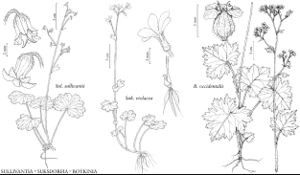Suksdorfia
Proc. Amer. Acad. Arts 15: 41. 1879, name conserved ,.
Herbs, not rhizomatous, not stoloniferous; base of slender caudex bearing bulbils. Flowering-stems erect, leafy, 8–40 cm, stipitate-glandular. Leaves in basal rosette and cauline; cauline leaves reduced distally; stipules of basal leaves inconspicuous, stipules of cauline leaves conspicuous; petiole sparsely to moderately stipitate-glandular; blade reniform to orbiculate, usually 3–9-lobed, base cordate to truncate, ultimate margins irregularly crenate, ciliate, apex obtuse to rounded, surfaces glabrous or sparsely stipitate-glandular; venation palmate. Inflorescences flat-topped panicles of simple or compound cymes, terminal from terminal bud in rosette, 2–35-flowered, bracteate or ebracteate. Flowers: hypanthium adnate to ovary in proximal 7/8, free from ovary 0.3–1 mm, greenish (with purple band distally in S. ranunculifolia); sepals 5, greenish (with purple margins in S. violacea); petals 5, white or pink, purple, or violet; nectary tissue partially covering ovary (in S. ranunculifolia) or absent (in S. violacea); stamens 5; filaments filiform; ovary 1/2–3/4 inferior, 2-locular, carpels connate proximally; placentation axile; styles absent or 2; stigmas 2. Capsules 2 (–3) -beaked. Seeds (50–75), dark-brown, ellipsoid and prismatic (or angular), warty. x = 7.
Distribution
w North America, South America (Argentina), South America (Bolivia)
Discussion
Hemieva Rafinesque, name rejected
Species 3 (2 in the flora).
Suksdorfia has been split into three monospecific genera by different authors. The work of R. J. Gornall and B. A. Bohm (1980, 1984, 1985) emphasized the similarities of the species in supporting a single genus concept. More recent, molecular data (D. E. Soltis et al. 1993; L. A. Johnson and Soltis 1994) suggest that S. violacea is more closely related to species of Bolandra, that S. ranunculifolia is more closely related to species of Boykinia, and that the two North American species indeed should be placed into monospecific genera. The South American species is S. alchemilloides (Grisebach) Engler of northern Argentina and Bolivia.
Selected References
None.
Lower Taxa
Key
| 1 | Leaf blades shallowly lobed; stipules of all cauline leaves conspicuous; petals erect, usually pink to violet, rarely white (sometimes drying bluish), elliptic to obovate, 6-9 mm. | Suksdorfia violacea |
| 1 | Leaf blades deeply lobed; stipules of proximal cauline leaves barely expanded bases of petiole, stipules of distal cauline leaves conspicuous; petals spreading, white (sometimes pink tipped), broadly elliptic to obovate, 3-5 mm. | Suksdorfia ranunculifolia |
"full" is not a number.
